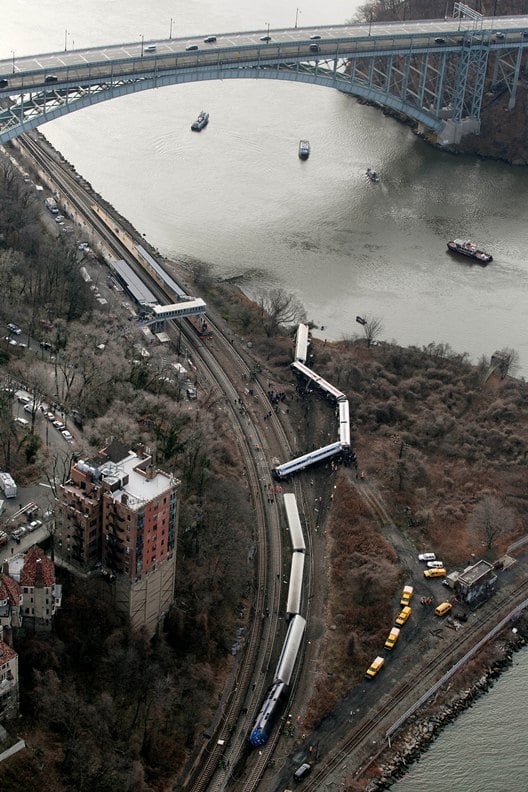 A commuter train operated by Metro-Northderailed early on Sunday morning, sending seven passenger carstoppling off tracks and nearly plunging them into the conjunctionof the Harlem and Hudson rivers. (See photo on left). Four peoplewere killed and 67 were injured.
A commuter train operated by Metro-Northderailed early on Sunday morning, sending seven passenger carstoppling off tracks and nearly plunging them into the conjunctionof the Harlem and Hudson rivers. (See photo on left). Four peoplewere killed and 67 were injured.
The train, which was traveling from Poughkeepsie and carryingabout 150 customers, jumped the tracks at a curve near the SpuytenDuyvil Station in the Bronx, just a few miles north of itsdestination at Manhattan's Grand Central Terminal.
|“That is a dangerous area on the track just by design,” said NewYork Governor Andrew Cuomo in a press conference following the 7:20AM accident. “The trains are going about 70 miles an hour comingdown the straight part of the track. They slow to about 30 milesper hour to make that sharp curve.
|“It's not that we have a curve here,” he continued, implyingthat speed was the cause of the catastrophe. “We've always had thisconfiguration but we didn't have accidents, so there has to beanother factor.”
|Click “next” to read more and see pictures from the deadlyderailment.
|Photos provided by AP Images.
||
According to a third-party claims adjuster with more than 40years of experience in the railroad industry, insurance falloutfrom a derailment may involve excess liability, wrongful death,property damage and rolling stock damage claims against therailroad company. Most railroads are self-insured for this kind ofcoverage. An Metropolitan Transit Authority (MTA) spokeswomanconfirms the company is self-insured up to $25 million.
|In the photo, first responders gather around the derailment onDec. 1, 2013. FDNY reported “multiple injuries” in the trainderailment, and 130 firefighters were on the scene.
||
Passenger train claims would mostly involve personal injuries,and the insured cost of such an event can go into the millions,says the adjuster, depending on the range of injuries. Officialssay some of the victims of the weekend's crash suffered compoundfractures, and one person may be paralyzed from the waist down.
|The Metro-North train was operating in “push” mode, or with thelocomotive at its rear, which the TPA says tends to involve morepersonal injuries when an accident occurs.
|Above, an Amtrak train, top, traveling on an unaffected track,passes the derailed Metro-North commuter train. The Metro-Northtrain derailed on a curved section of track early Sunday, coming torest just inches from the water. Police divers searched the watersto make sure no passenger had been thrown in, as other emergencycrews scoured the surrounding woods.
||
The New York Post reports the driver of Sunday'swrecked train, a 20-year MTA veteran with a clean safety record,stated that he attempted to apply the brakes before the derailment,but they failed.
|The National Transportation Safety Board (NTSB) has sent anevent recorder from the train to Washington for analysis. Aspokesperson for the Board says it may take more than a week toinvestigate the train's speed, brake application and throttlesetting at the time of the crash.
||
A freight train carrying garbage derailed at the same spot onJuly 18 and damaged 1,500 feet of track, records the MTA.
|In the photo, emergency personnel remove a body from the sceneof the derailment on Sunday. At least four people were killed.
||
The Metro-North Hudson Line, which had a ridership of almost 16million last year, suffered numerous mishaps in 2013, including apassenger train derailment on May 17 that caused $18.5 million indamages, a track foreman who was fatally hit by a train on May 28and a power outage in September that affected 132,000 passengersdaily.
|In the photo, injured people are tended to by firstresponders near the site of the derailment on Sunday.
||
The previous major train derailment in North America occurred inLac-Megantic, Quebec, in July, killing 50 people.
|Above, viewed from Manhattan, first responders and others workat the scene of Sunday's derailment.
||
The Federal Railroad Administration says that more than 3,000train accidents occur in the U.S. every year.
|As a safety measure, Metro-North is in the process of installingcontrol systems that automatically apply brakes if a train engineerfails to respond to an excessive speed alert.
|In the photo, cranes lift the derailed Metro-North train car onMonday, Dec. 2, 2013. Federal authorities began righting the carsMonday morning as they started an exhaustive investigation intowhat caused the incident.
Want to continue reading?
Become a Free PropertyCasualty360 Digital Reader
Your access to unlimited PropertyCasualty360 content isn’t changing.
Once you are an ALM digital member, you’ll receive:
- All PropertyCasualty360.com news coverage, best practices, and in-depth analysis.
- Educational webcasts, resources from industry leaders, and informative newsletters.
- Other award-winning websites including BenefitsPRO.com and ThinkAdvisor.com.
Already have an account? Sign In
© 2024 ALM Global, LLC, All Rights Reserved. Request academic re-use from www.copyright.com. All other uses, submit a request to [email protected]. For more information visit Asset & Logo Licensing.








